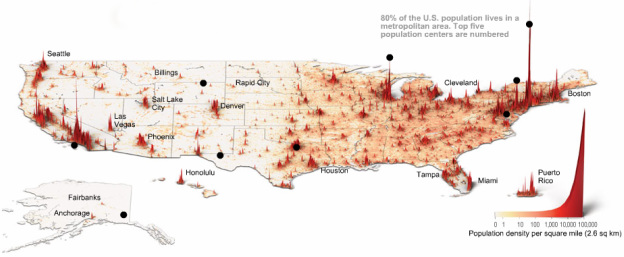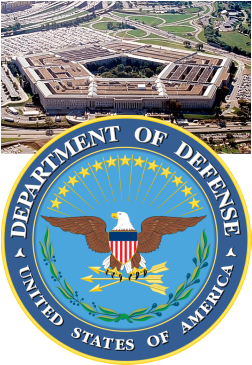The Impact of Population in the United States
Population affects the United States in multiple ways. Due to its significant population growth and successful industrialization, America has characteristics of both developing and developed nations.
Population of Contemporary America
According to the Census Bureau, in 2010 the US had a population of 309 million people, making it the 3rd most populated country, but like many developed countries, the United States is also experiencing a decline in its growth rate, now at 0.98% increase (which is still significant growth). Immigration and fertility rates are the main causes for this continued growth. In this ever changing nation, the face of America is also changing. Demographics reflect that the majority of Americans are white; however with a birthrate of 1.8 children in the average Caucasian woman's lifetime (less than the replacement rate of 2.1), other ethnic/racial groups like Hispanics, with an average birthrate of 3.0, and African Americans, with an average birthrate of 2.2, will eventually become the majority. This switch is expected to occur before 2050. The United States has typically been allied strongest with European nations, however as the majority of the population becomes decedent from other areas of the world, the future of US foreign relations may also reflect this shift. (Schmidt)
Density

The population density of the United States has beneficial and detrimental effects. Large urban centers like New York play a pivotal role in America's economic prowess; however, there are also adverse effects of a geo-culturally unique country such as energy problems.
The United States is the second largest energy consumer in the world. With this massive consumption, energy issues result from urban sprawl, the inefficient spread of cities, and greater traveling distances, being the 3rd largest country by land, the separation between cities is greater than more compact nations. Urban sprawl and suburbanization have led to a national dependence on cars for transportation. This creates a dependence on fossil fuels which in turn harm the environment by accelerating the Green House Effect. Some cities try and combat this need for cars by building mass transit systems like buses and subways. Washington DC and New York City subway systems are considered the best in the United States, sharply reducing the need for cars. Greater traveling distances, again affect the number of CO2 producing vehicles, however such distances also affect the efficiency of electrical energy usage. Most urban centers are spread out from each other with the main exception of the Eastern seaboard metropolis. This means that either smaller, less efficient power plants are built to serve these cities or the energy must be transported over vast distances with up to 10% of the power lost due to what is called , "line loss." Closer cities would reduce the effects of "line loss." From expenditure to modes of use, energy is a central variable affected by population density. (EIA) (pic, Census Bureau)
The United States is the second largest energy consumer in the world. With this massive consumption, energy issues result from urban sprawl, the inefficient spread of cities, and greater traveling distances, being the 3rd largest country by land, the separation between cities is greater than more compact nations. Urban sprawl and suburbanization have led to a national dependence on cars for transportation. This creates a dependence on fossil fuels which in turn harm the environment by accelerating the Green House Effect. Some cities try and combat this need for cars by building mass transit systems like buses and subways. Washington DC and New York City subway systems are considered the best in the United States, sharply reducing the need for cars. Greater traveling distances, again affect the number of CO2 producing vehicles, however such distances also affect the efficiency of electrical energy usage. Most urban centers are spread out from each other with the main exception of the Eastern seaboard metropolis. This means that either smaller, less efficient power plants are built to serve these cities or the energy must be transported over vast distances with up to 10% of the power lost due to what is called , "line loss." Closer cities would reduce the effects of "line loss." From expenditure to modes of use, energy is a central variable affected by population density. (EIA) (pic, Census Bureau)
Background: Department of Defense

The United States federal Department of Defense is the organization in charge of all governmental agencies relating to national security and the armed forces (army, navy, air force.) It has the largest financial budget of all federal departments with a congressional expenditure in the hundreds of billions. Commonly referred to as the DoD (Dee-Oh-Dee), its headquarters is located in Arlington Virginia at the Pentagon. The Secretary of Defense is the chief executive officer and 6th in succession of the Presidency. (pic, Eco Tech)
Interview at the Pentagon
The interview at the Pentagon with military and civilian Department of Defense employees informed us on actions America has taken in response to population problems at home and abroad. After the earthquake in Haiti of 2010, the primary population was displaced due to the destruction. Thousands of people were moved to temporary camps if they lost their homes; however, it became apparent that flooding would hit these new living camps during the rainy season. To avoid the loss of more human lives, cooperation between the American and Haitian governments helped relocate the camps to a safer location. In other countries, the Pentagon monitors the "sentiment" of populace towards the US, terrorism, and other governments. The utilization of social networking sites like Twitter and Facebook are used to judge the sentiment by identifying negative statements. In summary, the Pentagon uses population statistics to save lives and monitor relations with other peoples. (Stapleton)
The DoD is behind many international actions because military force is often the first wave of aid that hits a disaster area. Such involvement in the Indian tsunami of 2004 showed a great initiative by the Pentagon and US government to save the lives of those living in the disaster zone. As a result of this help, the American Department of Defense influences the world on both a regional and global scale.
The DoD is behind many international actions because military force is often the first wave of aid that hits a disaster area. Such involvement in the Indian tsunami of 2004 showed a great initiative by the Pentagon and US government to save the lives of those living in the disaster zone. As a result of this help, the American Department of Defense influences the world on both a regional and global scale.
